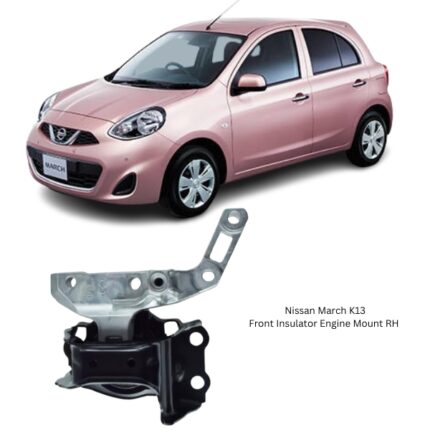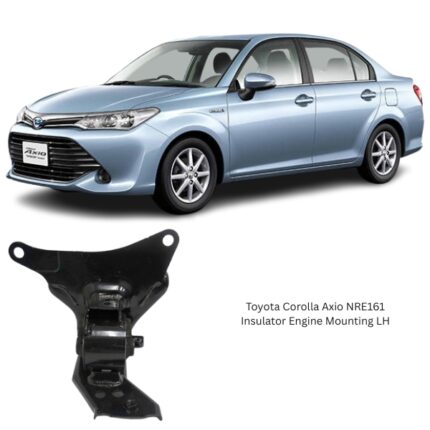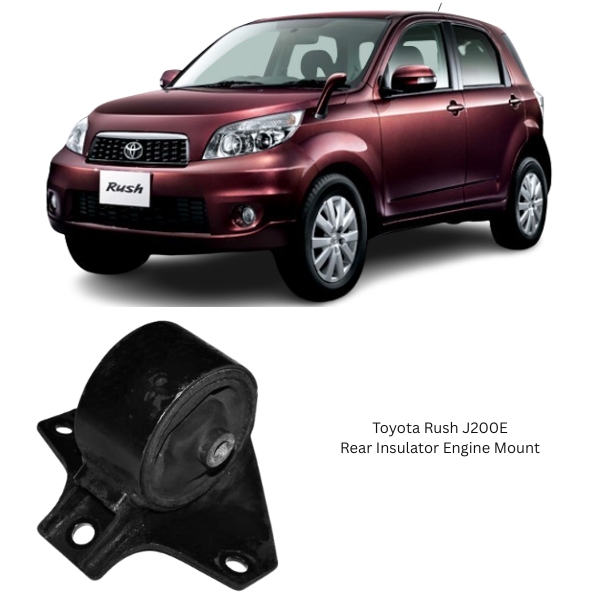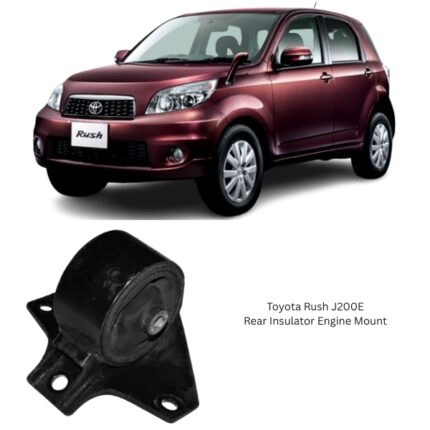Get Toyota Rush J200E Rear Insulator Engine Mount 12371-B4010 in Kenya
The Rear Insulator Engine Mount is an essential structural and vibration-damping component designed to support the rear section of a vehicle’s engine or transmission assembly. Strategically positioned at the back of the powertrain system—often between the engine and firewall or near the transmission cross-member—it plays a critical role in maintaining engine alignment, absorbing dynamic forces, and minimizing noise, vibration, and harshness (NVH).
Unlike front or side engine mounts, the rear insulator mount is particularly tasked with controlling fore-aft (front-to-back) engine movement and suppressing torque-related oscillations that occur during acceleration, gear shifts, or sudden deceleration. Constructed for durability and long-term performance, this mount contributes significantly to vehicle comfort, handling precision, and overall drivetrain integrity.
Primary Purpose and Function
The engine and transmission produce varying degrees of vibration and torque during operation. Without proper damping and support, these forces could transfer directly to the vehicle’s frame and interior, resulting in discomfort, component wear, and reduced safety. The Rear Insulator Engine Mount acts as a cushion and stabilizer, providing the following key functions:
-
Vibration Isolation: Reduces the transmission of engine and drivetrain vibrations into the cabin.
-
Torque Control: Prevents excessive rotation or “twisting” of the engine under torque load.
-
Engine Alignment: Maintains optimal positioning of the engine and transmission relative to the chassis.
-
Driveline Stability: Enhances the balance and efficiency of the entire powertrain system.
-
Shock Absorption: Softens impacts from rough roads, gear changes, and sudden stops.
The rear insulator mount is essential for preserving the performance and longevity of the engine, gearbox, driveshafts, exhaust, and various underhood components.
Design and Construction
Rear engine mounts are designed to withstand constant stress from both engine operation and road conditions. Depending on the application, they may vary in complexity—from conventional rubber mounts to more advanced hydraulic or electronically-controlled units.
Core Components:
-
Mounting Bracket
Usually made of high-strength steel or cast aluminum, this bracket bolts to the transmission housing, engine block, or subframe, serving as the primary structural link. -
Elastomeric Isolator (Rubber/Polyurethane)
This is the core damping element. It is bonded between two metal plates or sleeves and designed to absorb and neutralize vibrations across a broad frequency range. -
Inner Core/Bushing
Typically a steel or composite insert through which the mounting bolt passes. It provides support while allowing controlled movement. -
Hydraulic Chamber (in fluid-filled mounts)
Some rear mounts include a sealed cavity filled with special damping fluid that improves absorption at idle or under dynamic loads. -
Heat Shield (Optional)
In cases where the mount is close to exhaust or turbo components, a metal heat shield protects the rubber from thermal damage. -
Electronic Dampers (for active mounts)
Found in modern systems, these use electronically controlled mechanisms to adapt damping rates based on speed, load, and driving mode.
Performance Characteristics
The Rear Insulator Engine Mount is carefully engineered to balance rigidity and flexibility. Too soft, and the engine may move excessively; too stiff, and vibrations may be transmitted directly to the cabin. Properly functioning mounts exhibit the following performance attributes:
-
Stable Engine Support: Holds the engine and transmission firmly in place under load and at rest.
-
NVH Reduction: Limits vibrations felt through the chassis, floorboard, or steering.
-
Longevity Under Load: Maintains structural integrity under continuous thermal, mechanical, and chemical exposure.
-
Flexibility and Recovery: Offers controlled deflection during torque spikes and recovers to neutral position without permanent deformation.
Symptoms of a Worn or Faulty Rear Engine Mount
Like other rubber-based automotive components, the rear engine mount is subject to fatigue, heat degradation, and wear over time. When it fails or begins to deteriorate, it can cause several noticeable symptoms:
-
Clunking or Thudding Noises
Often heard during acceleration, deceleration, or gear shifts, these noises indicate excessive engine movement. -
Vibrations in Cabin
Increased vibrations felt in the center console, floor, or pedals—especially at idle or low speeds. -
Excessive Engine Rocking
Engine appears to shift or tilt significantly when revving or shifting gears. -
Misaligned Drivetrain
Premature wear of CV joints, driveshafts, or exhaust components due to misalignment caused by mount deflection. -
Visible Mount Damage
Cracked, torn, or collapsed rubber insulator; fluid leakage in hydraulic mounts; or broken brackets.
Addressing these issues promptly by replacing the mount ensures continued safety, comfort, and vehicle performance.
Installation Overview
Proper installation of the rear insulator mount is essential to restore drivetrain stability and eliminate abnormal vibration. While installation procedures vary by vehicle, the general steps include:
-
Vehicle Support
Safely raise and support the vehicle using ramps or a lift. Ensure the engine is securely supported using an engine hoist or jack with a block of wood. -
Component Removal
Remove any panels, covers, or components obstructing access to the mount, such as crossmembers or exhaust brackets. -
Unbolt the Mount
Loosen and remove the fasteners securing the mount to the chassis and engine/transmission assembly. -
Inspect Surrounding Area
Check the condition of other engine and transmission mounts to ensure they’re still structurally sound. -
Install New Mount
Align the new mount properly and torque bolts to manufacturer specifications. Ensure no misalignment or twisting during installation. -
Reassemble and Test
Replace any removed parts, start the engine, and observe for unusual noises or movement. A short test drive can confirm proper installation.
Maintenance and Inspection
Although engine mounts are largely maintenance-free, periodic inspections—especially during routine services—can prevent failure-related complications. Things to look for:
-
Dried, cracked, or torn rubber
-
Unusual engine behavior under load
-
Leaking hydraulic fluid (if equipped)
-
Vibrations at idle or acceleration
Inspection intervals may coincide with oil changes, brake service, or annual vehicle checks.
Benefits of Timely Replacement
Replacing a worn or broken rear engine insulator mount delivers noticeable improvements in performance and comfort:
-
Restores Smooth Engine Operation
Eliminates excessive vibrations and movements that impact driving experience. -
Protects Drivetrain Components
Prevents misalignment and undue stress on axles, transmission, and exhaust. -
Improves Gear Shifting
Ensures smoother and more precise shifts by limiting drivetrain slack. -
Reduces Noise and Harshness
Eliminates the creaks, clunks, and thuds associated with a failed mount. -
Preserves Vehicle Integrity
Maintains correct engine positioning, enhancing safety and structural balance.
Follow us on Facebook for more parts.





Reviews
Clear filtersThere are no reviews yet.